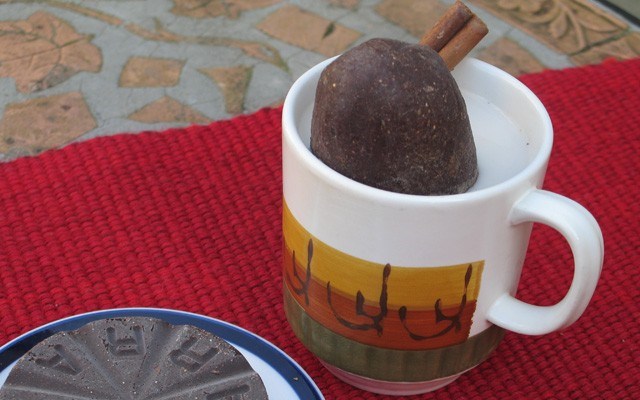Every so often in life something you eat or drink is so unusual it whacks you over the head, like a... well, like a big chocolate bola from the Dominican Republic (known colloquially as the DR, much like Kraft Dinner is called KD).
An interesting gift my adventurous pal, Virginia, gave me recently was just one of those things.
For years I lived in California and Arizona so close to the Mexican border I could toss a piñata over it. So I'm really familiar with the discs of Ibarra chocolate para mesa (table chocolate) made in Jalisco. Now with all our global homogenization, these discs of chocolate, sugar and cinnamon are even available in B.C. delis and big supermarkets.
Looking like a hockey puck, only one made of chocolate, these Ibarra treats can be nibbled like a chocolate bar. More traditionally, though, they're broken up and whirled into hot milk with a molinillo — an intricately carved wooden whisk — to make amazing hot chocolate. (To make it more traditional, à la Aztec- or Mayan-style, you simply add a pinch of cayenne.)
On the other hand, I've never in my life seen anything like a bola. But the cool thing is, turns out bolas are cousin to chocolate para mesa.
Even though cacao trees, which can grow to 14 metres, are native to Central and South America, they had to be imported to the DR. Likewise, the concept of forming it into hard shapes that, essentially, can be stored forever, came from the ancient Mayan culture of Central America.
In terms of colonial history, Christopher Columbus witnessed cacao being transported by a Mayan trader near what is now Honduras in 1502. Soon after tasting the delicious stuff and realizing its power to power people (observers noted you could march a whole day without food after you drank the local chocolate beverage), Columbus imported cacao trees to grow in the DR and provide high-calorie sustenance for Spain's colonial empire.
However, the chocolatey bola, unlike the puck of table chocolate, is an oblong with gravitas. It has the heft of a mini-whale, and looks more like one of those famous DR cigars (see Pique's travel story in Aug. 4 edition at www.piquenewsmagazine.com) only bigger and fatter. No denying it's just as traditional as one of those cigars, only this tradition is a lot better for you — it's made with roasted grains and a touch of cinnamon. No sugar. Plus it's good for the women who make it.
Other bolas are even more pure, made from nothing but cacao. After the raw cacao seeds are fermented, dried, and the protective shells removed, the cacao beans or nibs are traditionally ground by hand when they're made at home. But machines are used at the DR's Chocal women's cooperative — source of my wonderful bola along with jobs for 20 to 30 local women who had the grit to take a chance and start a co-op making bolas, and more, to create a better future for themselves and their families. (The average DR household income is US$6,000 annually.)
"There's so much fat inside the bean that the heat and friction of the grinding process liquefies that fat, so you get a wet paste the deep rich colour of chocolate," says Matthew Walsh, a Peace Corps volunteer with the Chocal collective, which, since 2007, has provided the women who own and operate it with a reliable income so they can improve their lives with things like a university education.
"From that wet paste you can form the bolas. If you're making 100-per-cent pure cacao bolas, you would take the wet paste and make it into balls or the oblong bola shape, and leave them to dry in the sun, then in the shade."
While I love to think of my fragrant bola lying under the big floppy leaves of a banana tree to dry, at Chocal they actually dry them in an air-con lab.
As for enjoying bolas, I like to munch mine straight up, just like I'm chewing on the end of a big old stogy. It's wonderfully earthy and chocolatey and buttery, with the toasted grains adding a nice texture and balance. And given its purity (sans sugar), I imagine the lift I get is something very close to what Columbus realized 500 years ago. Not that I'm going to try and conquer anyone.
More traditionally, though, Matthew says you're more likely to enjoy a bola in the Dominican Republic.
"The whole idea of the bola is to make hot chocolate. So you grate it down into hot water or hot milk, according to your taste, and make a really rich cup of hot cocoa," he says.
The bola is grated with a cheese grater right into the pot of milk or water warming on the stove. The fresh-hot cocoa is served in the morning for breakfast or in the evening for dinner, often with eiveres, a mixture of root veggies and squash, and bread dipped into the hot chocolate.
My interpretation of this traditional method is to simply let the bola sit in a cup of warm milk with a cinnamon stick, like in the photo above, letting the flavour melt into it as long as I like.
Grated or not, it's a great source of pleasure, all the more so knowing the income from its sale helped women improve their lives.
You can help make a bola yourself. Chocal is one of the adventures offered by an interesting new cruise company. Fathom, offers fun vacations where you can help worthwhile projects at the same time.
Glenda Bartosh is an award-winning journalist who is heartened that women's co-ops still exist somewhere.




